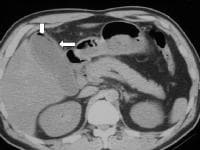Emphysematous cholecystitis, known less commonly as clostridial cholecystitis, is an acute infection of the gallbladder wall caused by gas-forming organisms (eg, Clostridium or Escherichia coli) that is generally considered a surgical emergency. An infrequent, insidious, and rapidly progressive form of acute cholecystitis, emphysematous cholecystitis is characterized by early gangrene, perforation of the gallbladder and high mortality. Although this condition develops in approximately 1% of all cases of acute cholecystitis, compared with typical acute cholecystitis, emphysematous cholecystitis is associated with much higher rates of gangrene and perforation of the gallbladder and significantly increased rates of mortality (15-25%).
An estimated 500,000 cholecystectomies are performed per year in the United States. Assuming all patients with emphysematous cholecystitis come to surgery, this would indicate that 5000 cholecystectomies are performed per year for emphysematous cholecystitis. Although the number of patients who are treated successfully without surgery is certainly small, the number of patients who die without surgery is unknown.
Usually, the diagnosis is made by the radiographic presence of air within the gallbladder wall or lumen. Elderly males, especially diabetics, are particularly susceptible to clostridial cholecystitis (emphysematous cholecystitis). The computed tomography (CT) scan below shows a patient with emphysematous cholecystitis.
 Emphysematous cholecystitis in a 47-year-old man with diabetes who experienced abdominal pain. This computerized tomography scan shows gas within the wall of the gallbladder (horizontal arrow) as well as within the lumen of the gallbladder (vertical arrow). Radiograph courtesy of Helen Morehouse, MD.
Emphysematous cholecystitis in a 47-year-old man with diabetes who experienced abdominal pain. This computerized tomography scan shows gas within the wall of the gallbladder (horizontal arrow) as well as within the lumen of the gallbladder (vertical arrow). Radiograph courtesy of Helen Morehouse, MD.
An estimated 500,000 cholecystectomies are performed per year in the United States. Assuming all patients with emphysematous cholecystitis come to surgery, this would indicate that 5000 cholecystectomies are performed per year for emphysematous cholecystitis. Although the number of patients who are treated successfully without surgery is certainly small, the number of patients who die without surgery is unknown.
Usually, the diagnosis is made by the radiographic presence of air within the gallbladder wall or lumen. Elderly males, especially diabetics, are particularly susceptible to clostridial cholecystitis (emphysematous cholecystitis). The computed tomography (CT) scan below shows a patient with emphysematous cholecystitis.
 Emphysematous cholecystitis in a 47-year-old man with diabetes who experienced abdominal pain. This computerized tomography scan shows gas within the wall of the gallbladder (horizontal arrow) as well as within the lumen of the gallbladder (vertical arrow). Radiograph courtesy of Helen Morehouse, MD.
Emphysematous cholecystitis in a 47-year-old man with diabetes who experienced abdominal pain. This computerized tomography scan shows gas within the wall of the gallbladder (horizontal arrow) as well as within the lumen of the gallbladder (vertical arrow). Radiograph courtesy of Helen Morehouse, MD.
ليست هناك تعليقات:
إرسال تعليق